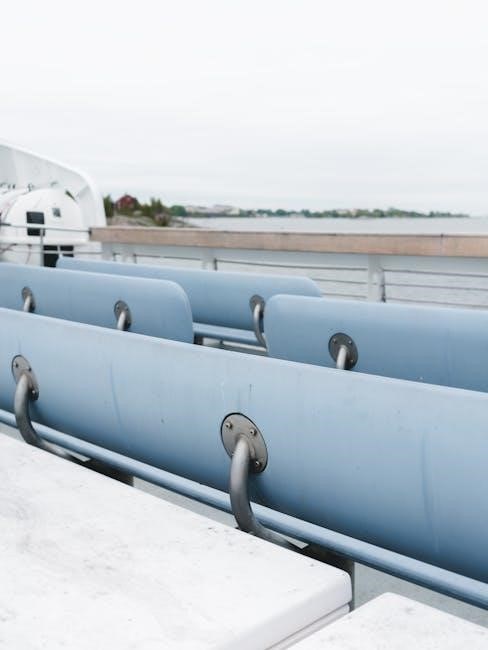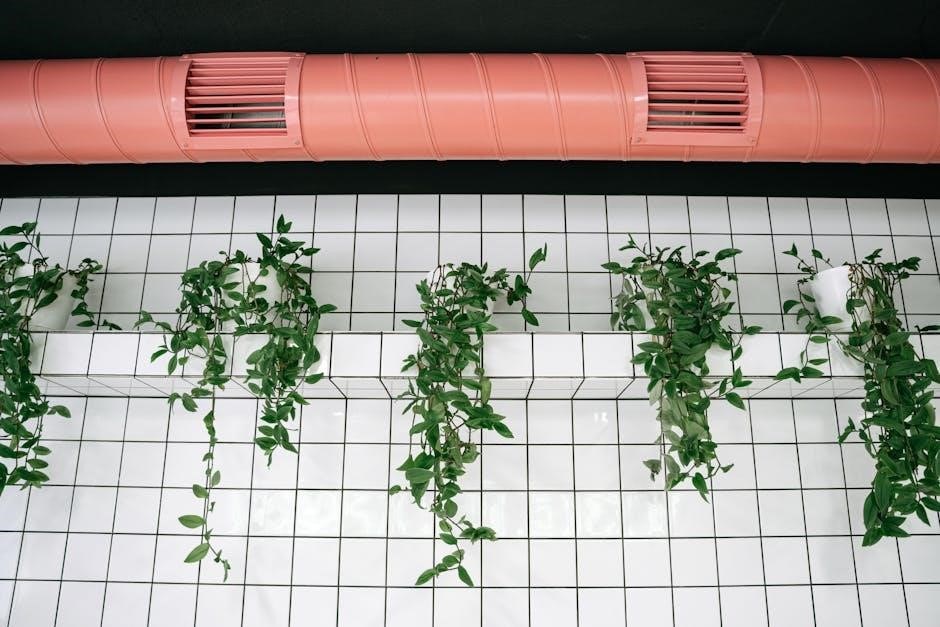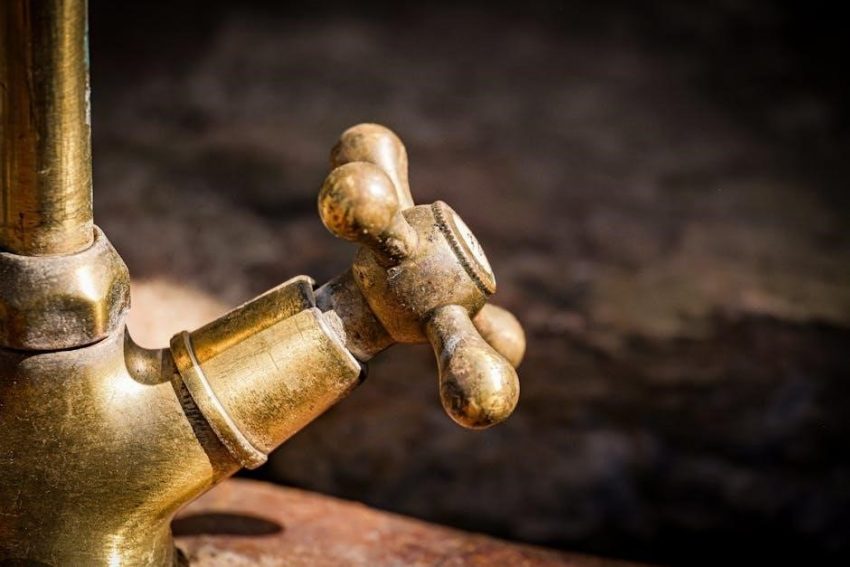Accurate pipe sizing ensures efficient water supply systems, balancing flow rates, pressure loss, and friction. Proper sizing optimizes performance, reduces costs, and meets safety standards, using tools like the IAPMO Water Demand Calculator.
What is Pipe Sizing?
Pipe sizing is the process of determining the optimal diameter of pipes to ensure efficient water supply systems. It involves calculating the correct pipe size based on factors like water demand, pressure loss, and flow velocity. Proper sizing ensures adequate water flow, minimizes energy losses, and prevents system overloading. Accurate calculations are critical to avoid oversizing, which increases costs, or undersizing, which reduces performance. Pipe sizing uses methods like the Uniform Pressure Loss approach and tools such as the IAPMO Water Demand Calculator. It also relies on charts and tables specific to pipe materials and friction losses. This process is essential for designing reliable and cost-effective water distribution systems in residential, commercial, and industrial settings.
Importance of Accurate Pipe Sizing
Accurate pipe sizing is crucial for ensuring efficient water supply systems. Proper sizing balances flow rates, pressure loss, and friction, preventing undersizing, which can lead to inadequate water supply and increased energy costs. Oversizing, on the other hand, raises initial costs and may result in lower water velocities, potentially causing issues like reduced flow rates. Correct pipe sizing ensures systems operate within acceptable pressure and flow limits, maintaining performance and reliability. It also minimizes waste, reduces wear and tear on components, and extends system lifespan. Accurate sizing is essential for both residential and large-scale water distribution systems, ensuring safe and efficient water delivery. Tools like the IAPMO Water Demand Calculator and pipe sizing charts simplify this process, helping designers achieve optimal results.

Key Factors Influencing Pipe Sizing
Water demand, pressure loss, flow velocity, pipe material, and building layout are critical factors. These elements ensure proper sizing, balancing performance, efficiency, and system reliability effectively.
Water Demand and Fixture Units
Water demand is calculated using fixture units, which represent the flow requirements of plumbing fixtures. Each fixture, such as sinks or toilets, has a specific demand weight. The total demand is the sum of all fixture units, converted to gallons per minute (gpm). For example, one fixture unit equals approximately 0.75 gpm. Continuous demands, like water heaters, must also be included. Accurate calculation ensures proper pipe sizing, balancing flow rates and pressure loss. The 2022 California Plumbing Code provides detailed tables for converting fixture units to gpm, helping designers determine the correct pipe size for efficient water supply systems.
Pressure Loss and Friction
Pressure loss and friction are critical factors in pipe sizing calculations. Friction loss occurs due to water flowing through pipes, fittings, and valves, converting kinetic energy into heat. The Hazen and Williams equation is commonly used to calculate friction loss, considering factors like pipe material, diameter, and flow rate. Accurate calculation ensures pipes are sized to maintain adequate pressure at all points in the system. Excessive pressure loss can lead to poor performance, while undersizing pipes increases friction and energy costs. Proper balancing of these factors ensures efficient water distribution, meeting system requirements and minimizing operational expenses.
Flow Velocity and Its Impact
Flow velocity significantly impacts pipe sizing and system performance. Higher velocities reduce pipe diameter requirements but increase friction loss and noise. Excessive velocity can lead to pipe erosion and wear, while low velocity may cause sediment buildup. Typically, water systems aim for velocities between 1-3 m/s to balance efficiency and longevity. Proper velocity management ensures optimal water distribution, minimizing energy costs and system wear. Velocity calculations are integral to pipe sizing, ensuring systems operate within safe and efficient parameters. Accurate velocity assessment is crucial for long-term system reliability and performance.
Pipe Material and Type
Pipe material and type significantly influence sizing calculations. Common materials include copper, PEX, PVC, and galvanized steel, each with unique properties affecting flow rates and friction loss. Copper and PEX are popular for their durability and resistance to corrosion, while PVC is cost-effective and lightweight. The choice of material impacts the Hazen-Williams coefficient, used in friction loss calculations. Different materials also have varying pressure ratings and compatibility with water types. Proper material selection ensures system longevity, efficiency, and compliance with local codes. Material-specific charts and tables are often referenced during sizing to ensure accurate calculations. The right material choice balances cost, performance, and durability for optimal water supply systems.
Building Layout and Distance
Building layout and distance play a crucial role in pipe sizing. The physical arrangement of fixtures, appliances, and water sources determines the length and complexity of piping. Longer distances between the water source and fixtures increase friction loss, potentially requiring larger pipe diameters to maintain adequate flow rates. The location of the farthest fixture from the water supply source is critical, as it often dictates the minimum pipe size needed. Additionally, the number of bends, elbows, and fittings in the system must be considered, as they add to pressure loss. Accurate measurements and layouts ensure efficient water distribution, minimizing energy losses and ensuring consistent water pressure throughout the building. Proper planning of the building layout simplifies the sizing process and optimizes system performance.

Methods for Pipe Sizing
Common methods include the Uniform Pressure Loss approach and the Water Demand Calculator (IAPMO). These tools help determine optimal pipe sizes for efficient water flow and cost savings.
Uniform Pressure Loss Method
The Uniform Pressure Loss Method ensures consistent pressure drop per linear foot of pipe, simplifying system design. It calculates friction loss uniformly across the piping network, ensuring balanced water distribution. This method is particularly useful for large systems, as it maintains even pressure throughout. By standardizing pressure loss, it helps in selecting appropriate pipe sizes and materials, reducing the risk of undersizing or oversizing. The approach aligns with industry standards and is widely adopted for its reliability and simplicity in achieving efficient water supply systems. Proper application of this method ensures optimal performance and cost-effectiveness in plumbing designs.
Water Demand Calculator (IAPMO)

The IAPMO Water Demand Calculator is a tool for determining water supply pipe sizes based on fixture units and system requirements. It simplifies calculations by converting fixture units to gallons per minute (gpm), enabling accurate pipe sizing. The calculator considers factors like water pressure, flow rates, and pipe material. By using this tool, designers can optimize pipe diameters, reducing material costs and ensuring efficient water delivery. The IAPMO method is recognized in plumbing codes and is particularly effective for residential and commercial systems. It promotes consistency and accuracy, making it a preferred choice for engineers and plumbers. Regular updates ensure compliance with the latest standards and practices.

Tools and Resources for Pipe Sizing
Essential tools include the IAPMO Water Demand Calculator, pipe sizing charts, and tables. These resources provide formulas, factors, and guidelines for accurate calculations, ensuring compliance with plumbing standards.
IAPMO Water Demand Calculator
The IAPMO Water Demand Calculator is a vital tool for determining water supply pipe sizes. It converts fixture units into gallons per minute (GPM), ensuring accurate sizing based on demand. By inputting data like fixture types and quantities, the calculator provides precise flow rates, helping designers optimize pipe diameters. This method reduces material costs and enhances system efficiency. Widely adopted in plumbing codes, it supports both residential and commercial applications, offering a user-friendly approach to complex calculations. Its accuracy ensures compliance with safety and performance standards, making it indispensable for modern plumbing design and installation.
Pipe Sizing Charts and Tables

Pipe sizing charts and tables are essential tools for determining the correct pipe diameter based on water demand and pressure loss. These tables, often found in plumbing codes, provide pre-calculated values for various pipe materials, such as copper, PEX, and PVC. By referencing these charts, designers can quickly identify the appropriate pipe size for a given flow rate in gallons per minute (GPM) and allowable friction loss. For example, Table 18-29-604.10.3 and Table 18-29-604.10.4 in the California Plumbing Code offer specific guidance for sizing water supply pipes. These resources simplify the sizing process, ensuring compliance with safety and efficiency standards while minimizing calculation errors.
How to Read Pipe Sizing Charts
Reading pipe sizing charts involves understanding the relationship between flow rate, pressure loss, and pipe diameter. These charts typically display flow rates (in GPM) on one axis and pipe sizes on the other, with lines representing allowable pressure loss. To use them, identify the required flow rate and maximum acceptable friction loss, then locate the intersection point on the chart. This will indicate the minimum pipe diameter needed. For example, using Table 18-29-604.10.3, designers can match the fixture units to the corresponding pipe size. These charts also account for material-specific factors, such as those calculated using the Hazen and Williams equation for plastic pipes. Proper interpretation ensures efficient and compliant system design.

Step-by-Step Pipe Sizing Process
The process involves gathering input data, calculating water demand, selecting pipe material, determining diameter, and calculating friction loss to ensure optimal system performance and compliance.
Gathering Input Data
Gathering input data is the first step in pipe sizing, involving the identification of fixtures, appliances, and their water demand in gallons per minute (gpm). This includes determining the total water supply fixture units (WSFU) for the system. Pressure requirements, pipe material properties, and the maximum allowable friction loss must also be considered. The distance from the water source to the farthest fixture and the system’s operating pressure are critical. Additionally, the number of simultaneous users and peak demand periods must be evaluated. This data is essential for accurate calculations and ensures the system meets performance and regulatory standards. Using tools like the IAPMO Water Demand Calculator can streamline this process.
Calculating Water Demand
Calculating water demand involves determining the total water flow rate required for all fixtures and appliances in the system. This is typically done by converting fixture units (WSFU) into gallons per minute (gpm) using standardized tables or the IAPMO Water Demand Calculator. The process includes summing the demand weights of all fixtures, considering simultaneous use, and applying factors for specific piping arrangements. For example, pipes supplying both hot and cold water may be sized at 75% of the total demand. Accurate calculation ensures the system meets peak demand without excessive pressure loss or undersizing. This step is critical for ensuring reliable water supply and system performance, as outlined in plumbing codes and standards.
Selecting Pipe Material and Size
Selecting the appropriate pipe material and size is crucial for ensuring system efficiency and durability. Common materials include copper, PEX, and PVC, each with specific advantages. Pipe size is determined by calculating the maximum water demand, pressure loss, and flow velocity. Charts and calculators, such as the IAPMO Water Demand Calculator, simplify the process by providing pre-calculated values for different materials and diameters. For example, Type K copper tubing is often used for water service lines due to its durability, while PEX is favored for flexibility. Proper sizing ensures minimal friction loss, optimal flow rates, and cost savings. Accurate selection also prevents undersizing, which can lead to reduced performance and increased energy costs. Always refer to local plumbing codes and standards for material approval and sizing guidelines.
Determining Pipe Diameter
Determining the correct pipe diameter involves analyzing water demand, pressure loss, and flow velocity. Charts like Table B.7.3A through B.7.3H provide pre-calculated values for materials such as copper tubing. For plastic pipes, the Hazen-Williams equation is often used to calculate diameter based on friction loss. The IAPMO Water Demand Calculator simplifies this process by converting fixture units to gallons per minute and recommending diameters. Additionally, steps like locating the demand on a chart and aligning it with the pressure loss column help pinpoint the optimal size. Accurate diameter determination ensures efficient flow rates, minimal pressure drop, and system reliability. Always cross-reference with local plumbing codes to ensure compliance and optimal performance.
Calculating Friction Loss
Friction loss in water supply pipes depends on factors like pipe material, diameter, and water velocity. The Hazen-Williams equation is commonly used to calculate friction loss, especially for plastic pipes. This equation considers the pipe’s roughness coefficient, flow rate, and length. For other materials, charts or tables specific to the pipe type, such as copper or PEX, provide pre-calculated friction loss values. Accurate calculations ensure minimal pressure drop, maintaining adequate water pressure at all fixtures. Incorrect sizing can lead to reduced flow rates or increased energy costs. Tools like the IAPMO Water Demand Calculator or friction loss charts simplify this process, ensuring compliance with plumbing codes and optimal system performance.

Case Study: Residential Water Supply
A single-family home’s water demand is calculated by converting fixture units to gallons per minute. Using the uniform pressure loss method ensures proper pipe sizing for optimal flow.
Example Calculation for a Single-Family Home
To size water supply pipes for a single-family home, start by determining the total fixture units. For example, a home with a kitchen sink (2 units), two bathrooms (3 units each), and a washing machine (4 units) totals 12 fixture units. Convert these to gallons per minute (gpm) using the IAPMO Water Demand Calculator, resulting in approximately 6.5 gpm. Next, select the pipe material, such as Type L copper, and use sizing charts to determine the appropriate diameter based on the calculated flow rate and allowable friction loss. For this example, a 1-inch pipe would be suitable, ensuring minimal pressure drop and adequate flow velocity. This method ensures efficient water distribution while minimizing material costs and energy usage.

Common Mistakes in Pipe Sizing
Common errors include oversizing, leading to higher costs and material waste, and undersizing, causing insufficient flow and pressure drops. Accurate calculations are essential to avoid these issues.
Oversizing Pipes

Oversizing pipes is a common mistake that leads to unnecessary costs and inefficiencies; Larger-than-required pipes increase material expenses, installation labor, and insulation needs. They also reduce flow velocity, potentially causing water hammer and corrosion risks. Oversizing often results from incorrect demand calculations or overestimating water usage. It can lead to higher energy consumption for pumping and increased system complexity. Proper sizing using tools like the IAPMO Water Demand Calculator ensures pipes are appropriately dimensioned, balancing cost and performance. Always verify fixture units and flow rates to avoid this error, as oversized systems are less efficient and more expensive to maintain over time.
Undersizing Pipes
Undersizing pipes is a critical error that leads to insufficient water flow and increased pressure loss. Smaller pipes cannot handle the required flow rates, causing poor system performance and reduced water pressure at fixtures. This issue often arises from incorrect calculations of water demand or fixture units. Undersized pipes also increase friction loss, leading to higher energy costs for pumping. Over time, this can result in premature wear and potential system failure. Proper sizing using tools like the IAPMO Water Demand Calculator ensures pipes meet demand without excessive pressure drop. Always verify flow rates and pressure requirements to avoid undersizing, as it directly impacts system efficiency and user satisfaction.
Accurate pipe sizing is crucial for efficient water supply systems. Using tools like the IAPMO Water Demand Calculator ensures optimal performance, reducing costs and enhancing reliability.
Accurate pipe sizing is essential for efficient water supply systems, ensuring adequate flow rates and minimizing pressure loss. Key factors include water demand, friction loss, and pipe material. Using tools like the IAPMO Water Demand Calculator simplifies calculations, while charts and tables provide quick references. Proper sizing reduces costs, enhances system reliability, and meets safety standards. Understanding fixture units and flow velocity is critical for optimal design. By following established methods and avoiding common mistakes, engineers and plumbers can ensure systems operate efficiently and sustainably. Regular updates to codes and tools, like the Uniform Plumbing Code, further refine the process, ensuring modern systems meet evolving demands.
Future Trends in Pipe Sizing
Advancements in pipe sizing technology are expected to streamline the process, enhancing accuracy and efficiency. The integration of AI and machine learning into sizing tools will enable real-time calculations and adaptive designs. 3D modeling and BIM (Building Information Modeling) will improve visualization and precision. Sustainable materials, like low-flow pipes, will gain prominence, reducing water waste and energy consumption. Updated codes, such as the Uniform Plumbing Code, will incorporate new methodologies, ensuring compliance with modern standards. These trends aim to create smarter, eco-friendly systems, lowering costs and improving performance. The future of pipe sizing lies in innovation, driving the industry toward greener and more efficient solutions.

